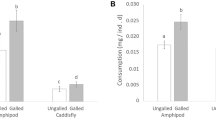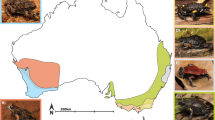Abstract
This study addressed the question of how caterpillars of Archips cerasivoranus feeding upon Prunus virginiana cope with the cyanogenic compounds of their food. Analysis by ion chromatography showed that young and aged leaves of P. virginiana consumed by the caterpillars during spring have hydrogen cyanide potentials (HCN-ps) of 2,473 ± 130 ppm and 1,058 ± 98 ppm, respectively. Although less than 3% of the cyanide released as the caterpillars feed escapes into the atmosphere, the larva’s bright-yellow aposematic coloration and conspicuous activity can not be attributed to the sequestration of cyanide. Only six of 25 samples of the caterpillars’ defensive regurgitants collected from 12 field colonies contained cyanide (17.6 ± 6.54 ppm), less than 5% of the quantity previously reported to occur in the regurgitant of the tent caterpillar M. americanum. Only seven of 13 caterpillars assayed had detectable quantities of cyanide in their bodies (3.9 ± 0.9 ppm). The fecal pellets that encase the cocoon contained no cyanide, nor did the frass that litters the leaf shelters. The small quantities of cyanide that occur in the caterpillar compared to the HCN-p of ingested plant material appear attributable to paced bouts of feeding and the maintenance of a highly alkaline foregut that inhibits cyanogenesis.


Similar content being viewed by others
References
Baird, A. B. 1918. Some notes on the natural control of the cherry-tree ugly-nest tortricid, Archips cerasivorana Fitch. Agric. Gaz. Can. 5:766–771.
Balduf, W. V. 1965. Observations on Archips cerasivoranus (Fitch) (Tortricidae: Lepidoptera) and certain parasites (Diptera: Hymenoptera). Ohio J. Sci. 65:60–67.
Brinker, A. M., and Seigler, D. S. 1989. Methods for the detection and quantitative determination of cyanide in plant materials. Phytochem. Bull. 21:24–31.
Brinker, A. M., and Seigler, D. S. 1992. Determination of cyanide and cyanogenic glycosides from plants, pp. 360–381, in H. F. Linskens, and J. F. Jackson (eds.). Plant toxin analysisSpringer, Berlin.
Conn, E. R. 1979. Cyanide and cyanogenic glycosides, pp. 387–412, in G. A. Rosenthal, and D. H. Janzen (eds.). Herbivores: their Interaction with secondary plant metabolitesAcademic, New York.
Engler, H. S., Spencer, K. C., and Gilbert, L. E. 2000. Preventing cyanide release from leaves. Nature 406:144–145.
Fitzgerald, T. D. 1993. Trail and arena marking by caterpillars of Archips cerasivoranus (Lepidoptera: Tortricidae). J. Chem. Ecol. 19:1479–1489.
Fitzgerald, T. D. 2008. Larvae of the fall webworm, Hyphantria cunea, inhibit cyanogenesis in Prunus serotina. J. Exp. Biol. 211:671–677.
Fitzgerald, T. D., Clark, K., Vanderpool, R., and Phillips, C. 1991. Leaf shelter-building caterpillars harness forces generated by axial retraction of stretched and wetted silk. J. Insect Behav. 4:21–32.
Fitzgerald, T. D., Jeffers, P. M., and Mantella, D. 2002. Depletion of host derived cyanide in the gut of the eastern tent caterpillar, Malacosoma americanum. J. Chem. Ecol. 28:257–268.
Grant, J. B. 2006. Diversification of gut morphology in caterpillars is associated with defensive behavior. J. Exp. Biol. 209:3018–3024.
Majack, W., Mcdiarmid, R. E., and Hall, J. W. 1981. The cyanide potential of Saskatoon serviceberry (Amelanchier alnifolia) and chokecherry (Prunus virginiana). Can. J. Sci. 61:681–686.
Meyers, D. M., and Ahmad, S. 1991. Link between l-3-cyanoalanine synthase activity and differential cyanide sensitivity of insects. Biochem. Biophys. Acta 1075:195–197.
Peterson, S. C., Johnson, N. D., and Leguyader, J. L. 1987. Defensive regurgitation of allelochemicals derived from host cyanogenesis by eastern tent caterpillars. Ecology 68:1268–1272.
Santamour, F. S. Jr. 1998. Amygdalin in Prunus leaves. Phytochemistry 47:1537–1538.
Snodgrass, R. E. 1961. The caterpillar and the butterfly. Smithsonian Misc. Collect. 143(6).
Swain, E., Li, C. P., and Poulton, J. E. 1992. Tissue and subcellular localization of enzymes catabolizing (R)-amygdalin in mature Prunus serotina seeds. Plant Physiol. 100:291–300.
Witthohn, K., and Naumann, C. M. 1987. Cyanogenesis—a general phenomenon in the Lepidoptera? J. Chem. Ecol. 13:1789–1809.
Acknowledgments
We gratefully acknowledge helpful information and comments provided by A. Esen, J. E. Poulton and D. S. Seigler during the preparation of the manuscript.
Author information
Authors and Affiliations
Corresponding author
Rights and permissions
About this article
Cite this article
Fitzgerald, T.D., Stevens, M.A., Miller, S. et al. Aposematism in Archips cerasivoranus Not Linked to the Sequestration of Host-derived Cyanide. J Chem Ecol 34, 1283–1289 (2008). https://doi.org/10.1007/s10886-008-9545-9
Received:
Revised:
Accepted:
Published:
Issue Date:
DOI: https://doi.org/10.1007/s10886-008-9545-9




